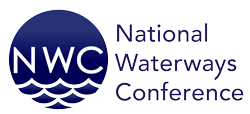Annual Meeting
2025 NWC Annual Meeting:
Celebrating 65 Years of NWC

2025 NWC Annual Meeting
September 23-25, 2025 | Norfolk, Virginia
*REGISTRATION IS NOW OPEN*
Join us in the historical coastal city of Norfolk for the National Waterways Conference (NWC) 2025 Annual Meeting, where we’ll gather in person to explore the pressing challenges and opportunities related to federal water and waterway resources.
This page will be updated soon with the latest agenda and speaker updates.
LOCATION
The meeting will be held at the Hilton Norfolk The Main, located at 100 E Main Street in downtown Norfolk. With Elizabeth River views and just minutes from the waterside, the hotel is less than a 10-minute walk from the Nauticus Maritime Museum and more than 50 restaurants!
HOTEL BLOCK
We’ve secured a special room block at The Hilton Norfolk The Main for NWC Annual Meeting attendees.
Details include:
- Rate: $199/night for single or double occupancy (plus taxes)
- Availability: Rooms can be booked for up to three days before and after September 23-25, subject to availability
- Guarantee: All reservations must be guaranteed with a major credit card
- Cancellation: Full refund available if canceled at least 48 hours prior to arrival date
- Deadline: Book by September 1, 2025 or until the block is full – rooms are limited!
Staying at the Hilton Norfolk helps NWC meet its room block commitment and avoid financial penalties. Thank you for your support!
REGISTRATION RATES
- Early Bird (Member): $799 (ends July 11, 2025)
- Regular (Member): $1025
- Non-Member: $1349
- First Time Attendee (non-member): $1175
- Spouse/Guest: $175 (for the September 23 Welcome Reception and September 24 Nauticus Museum Reception)
***Federal Government Employees: contact Cherise Green at for special registration pricing.***
SPONSORSHIP OPPORTUNITIES
Sponsorships are now available! To learn more, contact our Membership and Sponsorship Coordinator, Chelsea Polanco.
A heartfelt thank you to our early sponsors – we’re excited to partner with you!
Annual Meeting
Recognized for our timely and provocative programs, the NWC Annual Meeting (held in the fall) features knowledgeable and articulate participants and keynoters. Speakers have included Cabinet officials, Governors, and Congressional and industry leaders. In addition to the informative presentations and panel discussions, the meeting offers numerous opportunities for networking.
Past Annual Meetings
Local Host/Platinum Partner

Click here for Notice of Risk and Refund Policy.



